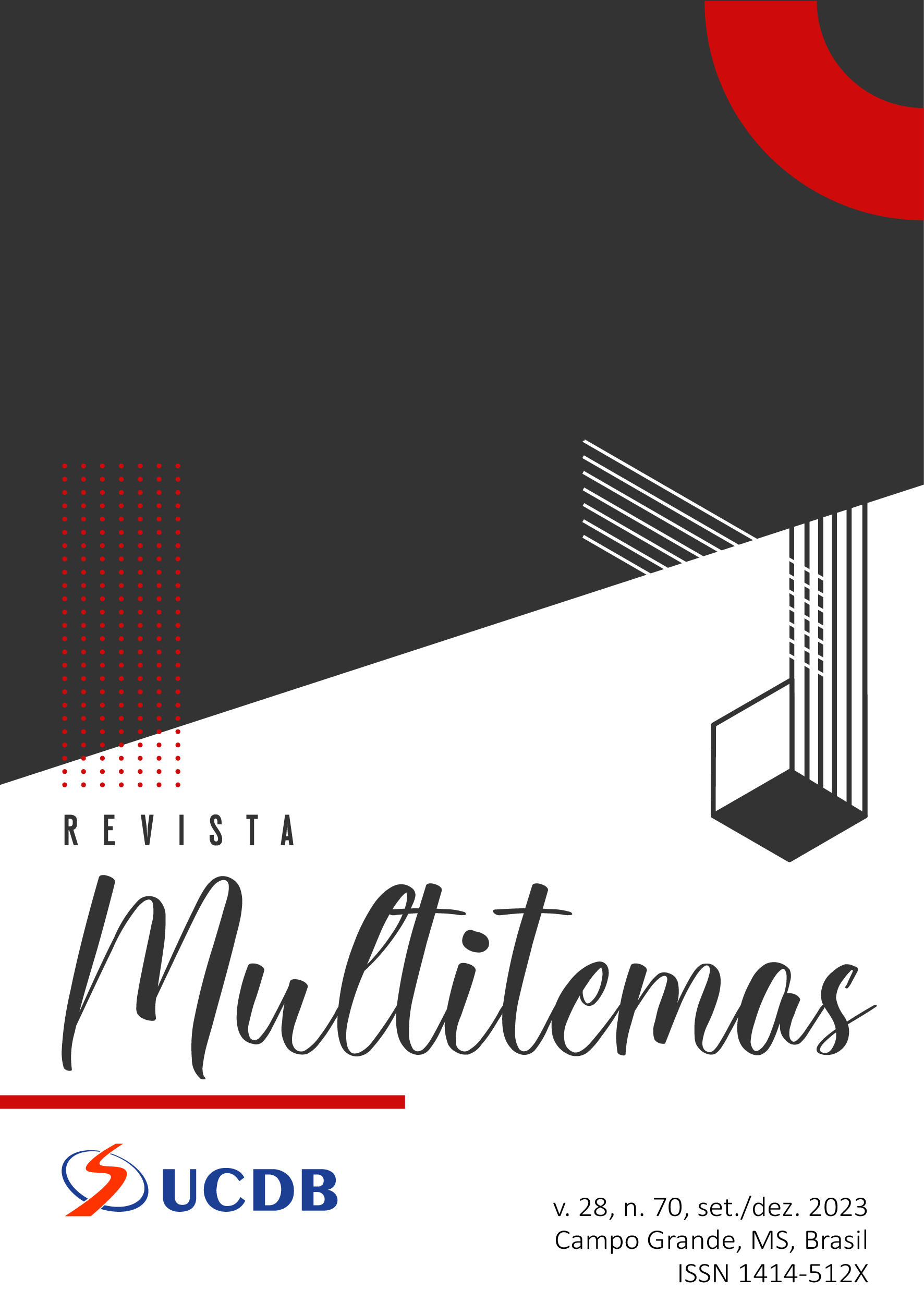Association of muscle weakness and the nutritional status of adults with post-COVID-19 syndrome
DOI:
https://doi.org/10.20435/multi.v28i70.3962Keywords:
acquired polyneuropathy, paresis, nutrition status, SARS-CoV-2Abstract
The study analyzed the possible association of post-COVID-19 nutritional status with the persistence of general muscle weakness. Participated 28 adults, of both sexes, between 20 and 59 years old. Current nutritional status, muscle tissue distribution, handgrip strength and possible complications presented during active infection were analyzed. Participants were divided into three groups: hospitalization for ≤30 days (n=7), hospitalization >30 days (n=7) and home isolation only (n=14). There was a predominance of moderate infections, without the need for hospitalization, pneumonia in 64,3%, intubation in 35,7% and tracheostomy in 17,6%. Most participants were overweight pre-COVID-19, eutrophic after curing the disease, and returned to overweight/obesity at the time of study collection. Even without considerable muscle depletion, global weakness persisted in 78,6% of the sample, suggesting that hyperinflammation initiated in COVID-19 perpetuates post-COVID, influencing sequelae such as sarcopenia regardless of protein malnutrition.
References
BLACKBURN, G. L.; THOTNTON, P. A. Nutritional assessment of the hospitalized patient. Medical Clinics of North America, [s l.], v. 63, n. 5, p. 11103-1115, sep. 1979. Disponível em: https://pubmed.ncbi.nlm.nih.gov/116095/. Acesso em: 14 abr. 2022.
CAPORRINO, F. A.; FALOPPA, F.; SANTOS, J. B. G.; RÉSSIO, C.; SOARES, F. H. C.; NAKACHIMA, L. R.; SEGRE, N. G. Estudo populacional da força de preensão palmar com dinamômetro JAMAR. Revista Brasileira de Ortopedia, São Paulo, v. 33, n. 2, p. 1-5, fev. 1998. Disponível em: https://cdn.publisher.gn1.link/rbo.org.br/pdf/33-2/1998_fev_04.pdf. Acesso em: 21 abr. 2022.
CASTRO-DE-ARAUJO, L. F.; STRINA, A.; GRASSI, M. F. R. G.; TEIXEIRA, M. G. Aspectos clínicos e terapêuticos da infecção da COVID-19. Arca Fiocruz, Salvador, mar. 2020. Disponível em: https://www.arca.fiocruz.br/handle/icict/40662#:~:text=Este%20documento%20tem%20como%20prop%C3%B3sito,da%20alta%20transmissibilidade%20do%20seu. Acesso em: 29 jan. 2023.
MACEDO, A. V.; ROCHA, M. O. C. Avaliação e tratamento da perda de peso involuntária e significativa. Revista Médica de Minas Gerais, Belo Horizonte, v. 20, n. 1, p. 115-23, set. 2010. Disponível em: https://rmmg.org/artigo/detalhes/390. Acesso em: 29 jan. 2023.
PRADO, P. R.; GIMENES, F. R. E.; LIMA, M. V. M.; PRADO, V. B.; SOARES, C. P.; AMARAL, T. L. M. Fatores de risco para óbito por COVID-19 no Acre, 2020: coorte retrospectiva. Epidemiologia e Serviços de Saúde, Brasília, v. 30, n. 3, p. 1-11, jul. 2021. Doi: https://doi.org/10.1590/S1679-49742021000300018.
SILVA, L. B. D.; SOUZA, C. E. P.; SARAIVA, D. G.; SANTOS, A. R. A.; ARAÚJO, R. Q. O. Prevalência de fraqueza muscular em paciente pós COVID-19: uma revisão integrativa de literatura. International Journal of Development Research, [s.l.], v. 11, n. 10, p. 50863-866, oct. 2021. Doi: https://doi.org/10.37118/ijdr.23179.10.2021
SONG, W. J.; HUI, C. K. M.; HULL, J. H.; BIRRING, S. S.; MCGARVEY, L.; MAZZONE, S. B.; CHUNG, K. F. Confronting COVID-19-associated cough and the post-COVID-syndrome: role of viral neurotropism, neuroinflammation, and neuroimmune responses. The Lancet Respiratory Medicine, [s.l.], v. 9, n. 5, p. 533-44, apr. 2021. Doi: https://dx.doi.org/10.1016%2FS2213-2600(21)00125-9.
STUKALOV, A. et al. Multilevel proteomics reveals host pertubrations by SARS-CoV-2 and SARS-CoV. Nature, London, v. 594, p. 246-82, apr. 2021. Doi: https://doi.org/10.1038/s41586-021-03493-4
TANRIVERDI, A.; SAVCI, S.; KAHRAMAN, B. O.; OZPELIT, E. Extrapulmonary features of post-COVID-19 patients: muscle function, physical activity, mood, and sleep quality. Irish Journal of Medical Science, [s.l.], v. 191, n. 3, p. 969-75, jun. 2022.
TOLEDO, D. O. et al. Campanha “Diga não à desnutrição”: 11 passos importantes para combater a desnutrição hospitalar. Braspen J., São Paulo, v. 33, n. 1, p. 86-100, mar. 2018. Disponível em: http://arquivos.braspen.org/journal/jan-fev-mar-2018/15-Campanha-diga-nao-aadesnutricao.pdf. Acesso em: 14 abr. 2022.
WORLD HEALTH ORGANIZATION [WHO]. Physical Status: the use and interpretation of anthropometry. [Technical Report Series, 854]. Genebra: WHO, 1995. Disponível em: https://apps.who.int/iris/bitstream/handle/10665/37003/WHO_TRS_854.pdf?sequence=1&isAllowed=y. Acesso em: 14 abr. 2022.
YU, L.; ZHANG, X.; YE, S.; LIAN, H.; WANG, H.; YE, J. Obesity and COVID-19: Mechanistic insights from adipose tissue. The Journal of Clinical Endocrinology and Metabolism, London, v. 107, n. 7, p. 1799-811, jun. 2022.
Downloads
Published
How to Cite
Issue
Section
License
Copyright (c) 2023 Lucas Gerke Cordeiro, Fernanda Zanoni Cônsolo

This work is licensed under a Creative Commons Attribution 4.0 International License.
Os artigos publicados na Revista Multitemas têm acesso aberto (Open Access) sob a licença Creative Commons Attribution, que permite uso, distribuição e reprodução em qualquer meio, sem restrições desde que o trabalho original seja corretamente citado.
Direitos Autorais para artigos publicados nesta revista são do autor, com direitos de primeira publicação para a revista. Em virtude de aparecerem nesta revista de acesso público, os artigos são de uso gratuito, com atribuições próprias, em aplicações educacionais e não-comerciais.


